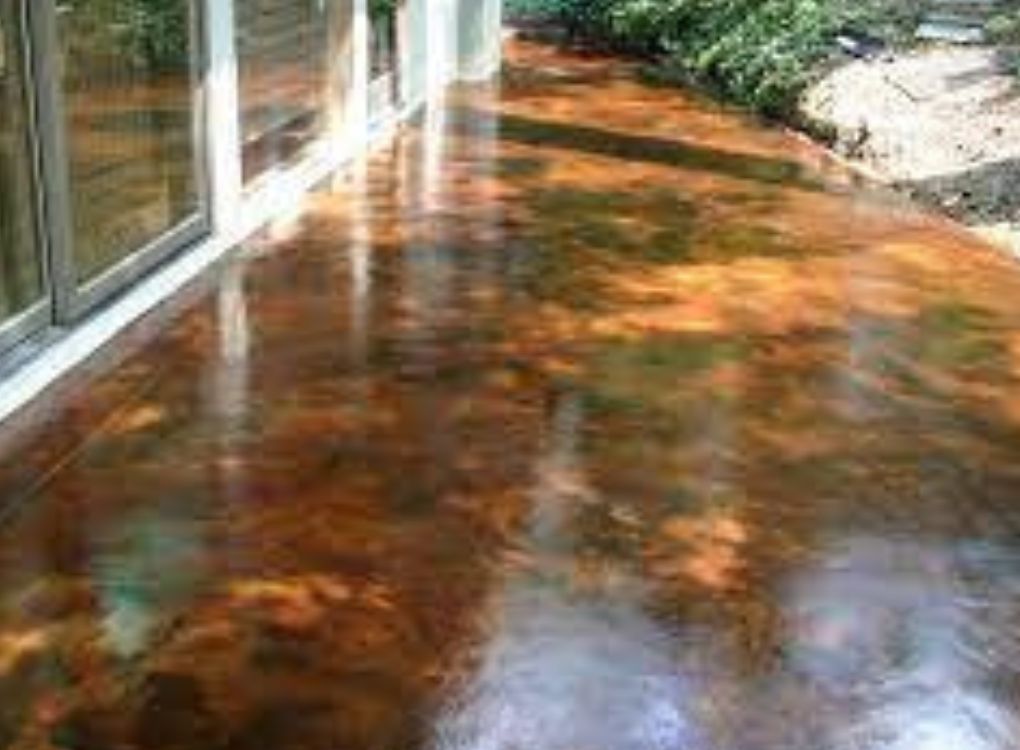What is concrete staining?
Applying a semi-transparent color to the surface of a concrete floor is known as concrete staining. It can be used to produce several effects, such as a natural stone look or a marbled impression, and is frequently used to improve the appearance of concrete surfaces. A permanent color that won’t fade or peel off is produced by the stain’s chemical reaction with the minerals after penetrating the concrete’s pores. Because concrete staining is affordable, enduring, and low-maintenance, it is a popular option for both residential and commercial uses.
The Different Types of Concrete Stains
Acid Based Stain
Acid-based stains are a popular option for giving concrete surfaces a unique and appealing appearance. These stains penetrate the concrete’s surface and interact with its minerals to create a durable, varied color that is impossible to achieve with other coloring techniques.
The components of acid-based stains are water, hydrochloric acid, and metallic salts. The acid in this mixture reacts with the calcium hydroxide in the concrete to produce calcium chloride and water when it is applied to the concrete’s surface. The metallic salts can then infiltrate the concrete’s pores as a result of this reaction, where they interact with the free lime and other minerals to give the concrete its distinctive color.
Benefits of an Acid-Based Stain
Acid-based concrete stains have several advantages.
- First of all, they fully penetrate the concrete’s surface to produce a color that will last forever and won’t chip or peel.
- Second, they create a unique and varied appearance that resembles marble or genuine stone. Finally, they can be applied to internal and external concrete surfaces, such as countertops, floors, and walls.
- Moreover, acid-based stains can tolerate high foot traffic, UV light exposure, and fading.
- Finally, they can be tailored to generate a variety of colors and effects and are often simple to apply.
Disadvantages of acid-based concrete stain
The use of acid-based concrete stains has some drawbacks. Since the application procedure entails a chemical reaction with the concrete surface, one of the main problems is that it can be challenging to apply. This implies that the stain might not always penetrate uniformly, leaving a blotchy or uneven appearance.
The fact that acid-based stains are not UV-resistant is another disadvantage. As a result, prolonged exposure to sunlight may cause the color to fade. In addition to requiring more preparation and cleanup, they are also frequently more expensive than other types of stains.
Acid-based stains should also be used carefully because they can affect the environment. Before applying the stain, suitable protection equipment should be used because the chemicals used in the staining process can be harmful to both humans and animals.
Finally, acid-based stains may not be the ideal choice for everyone, even though they can give concrete surfaces a distinctive and attractive appearance. Before choosing to use this type of stain, it is crucial to weigh the possible disadvantages.
Water Based Stain
Concrete stains that use water as a solvent rather than chemicals are known as water-based stains. Typically, this kind of stain is composed of a mixture of water, pigment, and a small quantity of acrylic or a different type of resin.
Concrete that has been stained with water-based products has a transparent color that allows the concrete’s natural variances and texture to shine through. They come in several colors and can be applied to produce a range of effects, from a soft wash of color to a strong, dramatic look.
The fact that water-based concrete stains are non-toxic and environmentally beneficial is one of their main advantages. They don’t release many volatile organic compounds (VOCs), which are harmful to the environment and human health. They are a realistic choice for DIY projects because they are simple to clean up with soap and water.
Water-based concrete stains are often simple to apply and dry rapidly, which can save time and lessen the chance of damaging or ruining nearby surfaces. They are appropriate for floors, walls, counters, and other inside and external concrete surfaces. They can also be used to make decorative patterns and designs, like stamped or stenciled designs.
Advantages of water-based concrete stain
Using a water-based concrete stain over other stains has several benefits, including:
- Eco-friendly: Water-based stains are non-toxic and release a few volatile organic chemicals (volatile organic compounds). Because of this, they are a safer and more environmentally friendly solution for use both inside and outside.
- Simple to use: Water-based stains are quick and simple to remove with soap and water. They also dry fast, allowing many coats to be applied in a single day.
- Versatile: Concrete, brick, and stone are just a few of the surfaces that water-based stains can be applied to. Moreover, they can be utilized to create a wide range of hues and effects, from subdued to striking.
- Long-lasting: Water-based stains give concrete a long-lasting color that won’t fade or peel over time because they fully penetrate the concrete.
- In conclusion, a water-based concrete stain is a fantastic option for anyone wishing to improve the appearance of their concrete surfaces in a secure, adaptable, and durable manner.
Water-based concrete stain drawbacks
You should be aware of the several drawbacks of water-based concrete staining.
- First off, compared to acid-based stains, water-based stains often have less vibrant colors. As a result, they might not offer as much color depth and diversity as acid-based stains.
- Furthermore, water-based stains take significantly longer to dry than acid-based stains do. If you have a tight deadline or little time to work with, this could be an issue.
- Moreover, water-based stains are frequently less resilient than acid-based stains. They might not withstand strong foot traffic or exposure to the environment as well, which could eventually cause fading or discoloration.
- Last but not least, water-based stains typically cost more than acid-based stains. Because of this, they might be less affordable or easier to get for individuals trying to finish a big job.
Acrylic Stain
Concrete surfaces can be colored and embellished with acrylic concrete stains. It is manufactured with a water-based acrylic solution that may be used on concrete surfaces both inside and outside. The stain seeps into the concrete surface to produce a long-lasting, semi-transparent color that improves the concrete’s texture and beauty.
The colors of acrylic concrete stains can be blended to create unique colors that range from earth tones to vibrant hues. Moreover, it comes in opaque and transparent finishes, letting the concrete’s organic texture and character shine through.
Benefits of Acrylic Concrete Stain
For coloring and enhancing concrete surfaces, acrylic concrete stains have several advantages:
- Long-Lasting and Durable: Acrylic concrete stains are exceptionally long-lasting and resistant to fading, flaking, and peeling. It offers a durable remedy for improving the look of concrete surfaces.
- Flexibility: Acrylic concrete stain is offered in a variety of hues and sheens, enabling customization and design flexibility.
- Improves Texture: By penetrating the concrete surface and leaving behind a semi-transparent color, the stain improves the texture and personality of the concrete.
- Simple to Apply: Acrylic concrete stain is convenient for DIY projects since it can be applied quickly and easily with a brush, roller, or sprayer.
- Low-Maintenance: Acrylic concrete stain is a cost-effective way to improve the appearance of concrete surfaces because it requires minimal maintenance after application.
- Eco-friendly: Acrylic concrete stain is an environmentally friendly, water-based product with low volatile organic compounds (VOCs).
Read Also: 20 Steps the Essential Use Of Additives For Concrete
How to Choose the Right Stain for Your Project
It can be difficult to choose the best concrete stain for your project; however, the following elements should be taken into consideration:
- Surface Type: The type of stain you should choose will depend on the type of concrete surface you are staining. For instance, a floor inside will need a different stain than a driveway outside.
- Color: Think about the color you want and if a solid color or a transparent finish that lets the concrete’s rough texture show through is what you prefer. To assist you in selecting the ideal color for your project, the majority of manufacturers provide color charts.
- Stain Type: Acid-based and acrylic-based concrete stains are the two main varieties. Acid-based stains seem marbleized and variegated and are best used on outdoor surfaces. Acrylic stains are perfect for interior surfaces since they are water-based and produce more consistent color.
How to Prepare Your Surface and Apply the Stain Properly
You must first give your surface a thorough cleaning to get it ready for concrete staining. This includes getting rid of any possible stains, dirt, or debris. To achieve this, you can use a scrub brush and cleaning solution or a power washer. You should give the surface time to totally dry after cleaning.
The next step is to look for any damage or cracks in the surface. If there are any holes or cracks, you should patch them with concrete patching material and let them fully dry. This will make it more likely that the stain will spread evenly and smoothly.
Applying the concrete stain following the manufacturer’s instructions is then possible when the surface has dried completely and any cracks have been filled. This can entail applying the stain in a thin, even coat with a sprayer or a roller.
In general, making sure your surface is clean, dry, and devoid of any damage or flaws is essential for properly preparing it for concrete stain. You can make sure that the stain will adhere correctly and last for a long time by taking the time to properly prepare the surface.
How to apply the concrete stain properly
You should adhere to the following procedures to correctly apply concrete stain:
- Test the stain: To make sure you like the color and quality of the stain, test it on a small, inconspicuous area before staining the entire surface.
- Apply the stain: After achieving the ideal shade and finish, begin staining. To apply the stain in even, thin coats, you can either use a sprayer or a roller. Make sure to adhere to the manufacturer’s recommendations for coat thickness and drying intervals.
- Let the spill dry. You must let the final coat of stain completely dry after applying it. This could require several hours or perhaps an entire night.
- Seal the stain: To protect it and give it a glossy finish, treat the stain with concrete sealer after it has dried. The sealer can be applied with a sprayer or a roller in thin, even applications.
- Let the sealant cure. It is safe to re-cross the concrete after the sealant has dried.
What are the best methods for applying a concrete stain?
Depending on the kind of stain and the intended result, there are various ways to apply a concrete stain. Here are a few of the most popular techniques:
- Spray-on application: With this technique, the stain is applied to the concrete surface using a sprayer to disperse it uniformly. For large, flat expanses, it works nicely.
- Brush-on application: With this technique, the stain is applied to the concrete using a brush. It is frequently utilized for smaller areas or regions with complicated designs since it provides greater control and precision in application.
- Roll-on application: With this technique, the stain is applied to the concrete using a paint roller. It’s a quick and simple strategy that excels in larger spaces.
- Applying the stain using a sponge: In this technique, the stain is applied to the concrete using a sponge. It is frequently used to provide a mottled or variegated appearance and enables greater control and precision in application.
What are the benefits of using concrete stains over paint?
Concrete stains have several advantages over-dyed paints.
- Concrete stains have a strong permanent bond that resists fading, chipping, and peeling and penetrates deeply into the concrete surface. On the other hand, dye paints tend to linger on the concrete’s surface and may fade more quickly.
- Flexibility: Concrete stains are available in many hues and can be utilized to produce a range of effects, from delicate to striking. Moreover, they can be utilized to replicate the appearance of real stone, tile, or wood. On the other hand, dye paints are constrained by a narrower color spectrum and might not be able to produce the same level of texture and depth.
- Environmentally friendly: Compared to dye paints, concrete stains are typically thought to be more environmentally benign. Several stains use water as their base and are safer for the environment than conventional solvent-based paints.
- Maintenance: After they are placed, concrete stains require very little upkeep. They are not susceptible to flaking, peeling, or fading.
Conclusion
Concrete staining is the process of painting a concrete surface with a transparent color. Concrete can be stained with both acid- and water-based dyes. Acid-based stains chemically react with the concrete to produce a unique color and pattern, whereas water-based stains penetrate the concrete and deposit pigments into the pores to provide a more consistent color.
Concrete staining is a multi-step process that begins with scrubbing the concrete’s surface to get rid of any dirt or debris. The stain is then applied with a brush or sprayer and given time to dry for several hours. A sealer is used to protect the surface and bring out the color once the stain has cured. Depending on the intended outcome, the sealer may be a water-based or solvent-based solution that offers a glossy or matte surface.
Overall, concrete staining may be used to achieve many effects and is a terrific approach to improving the visual appeal of concrete surfaces.





